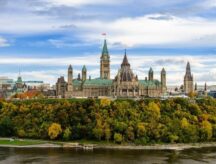Canada extends application window for judicial review of immigration applications
Canadian immigration applicants now have more time to request judicial review.
Canada’s Federal Court has issued special measures that give applicants an additional 45 days to apply for judicial permission (formally called “leave”) to review their immigration decisions.
Join the Angus Reid Forum and get $5 in points!
Prior to these new measures, applicants had only 30 days.
When an applicant obtains leave for judicial review, a Canadian federal court will review the immigration department’s decision, and may take steps such as returning a rejected application for processing if it was rejected on the basis of a misunderstanding or an error of law.
The court issued these special measures on May 14, 2025.
This change has been made in response to the swelling backlog of applications for leave and judicial review throughout 2024 and 2025.
Context for recent changes to the judicial leave and review process
The process of reviewing an immigration decision under the Federal Court review typically involves two stages:
- The judicial leave stage; and
- The judicial review stage.
Under the new changes, applicants will now have 45 additional days to “perfect an application for leave”.
This means that after filing their initial request for leave, applicants will now have 75 days (instead of the previous 30 days) after making their initial request to perfect their application and submit their full applicant record for the court to consider.
These 75 days will start:
- After filing the initial application for leave; OR
- After receiving the written reasons for the initial immigration refusal (if not included when the decision was initially received); OR
- After receiving written notice that no reasons for the initial refusal are available.
To give further context for this change, the following list will detail the entire process of applying for leave:
Step-by-Step Guide to Applying for Judicial Review
1. Apply for Judicial Review
You (the applicant) must submit an initial application for leave and for judicial review to the Federal Court.
This must be done in a specific time frame from when you received your initial decision, either
- Within 15 days if you are in Canada; or
- Within 60 days if you are outside Canada.
2. Provide Proof of Service
After serving your application to the respondent (the decision-making party on your immigration application), you must file proof that you did so.
This must be done within 10 days of serving your initial application.
3. Respondent files a Notice of Appearance
The respondent must file a notice indicating they will participate in the case. This must be done within 10 days after they are served with your application.
4. Court requests written reasons (if not initially provided to the applicant)
If the decision you’re challenging didn’t initially come with written reasons for refusal, the court will request them from the administrative party referred to formally as the tribunal.
5. Tribunal sends written reasons, or notice that reasons do not exist
The tribunal must (without delay) send the written reasons to all parties involved, or notify them that no reasons exist.
6. Submit your applicant record (this is where the new changes apply)
You must submit a record that includes relevant documents and arguments (known formally as an applicant record).
This must be done:
- Within 75 days of filing your application (if you already had the reasons), or
- Within 75 days of receiving the tribunal’s reasons or notice that no reasons will be provided.
7. Respondent submits their affidavits and arguments
The respondent has 30 days from the date they receive your applicant record to submit their own documents and legal arguments.
8. Optional reply
You can file a reply to the respondent’s arguments if you wish. This must be done within 10 days of receiving their submissions.
9. Court reviews leave request
The Court decides whether to grant "leave" (permission) for your case to proceed.
If leave is refused, the process ends, and the decision cannot be appealed.
If leave is granted, the Court:
- Sets a hearing date for the judicial review, and
- Provides deadlines for any remaining documents and tribunal records.
What are the possible outcomes of this process?
If the Federal Court agrees with the original decision and finds no legal error, the initial decision will be upheld.
If the Federal Court sends your case back to the decision-making party, it will be reviewed again. However, this does not guarantee that the original decision will be changed.
- Do you need Canadian immigration assistance? Contact the Contact Cohen Immigration Law firm by completing our form
- Send us your feedback or your non-legal assistance questions by emailing us at media@canadavisa.com







